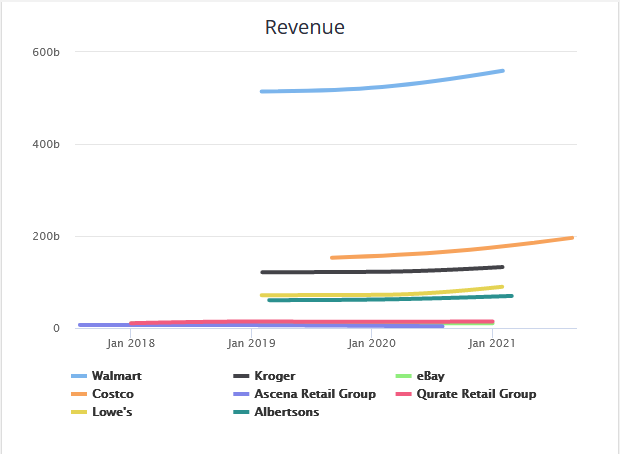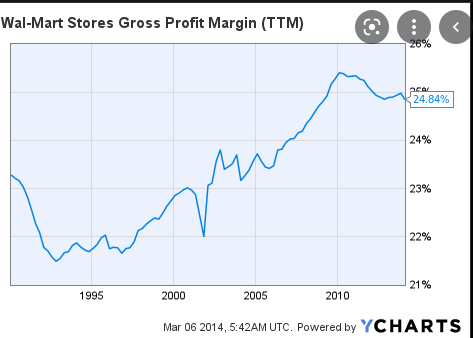Introduction
This report will provide an overview of Walmart’s background, the industry, and competition. We will then explore how Walmart approaches reward, recognition, and teamwork. Reizer et al. (2019) define organizational behavior as the influence of human behavior on employee productivity, workplace experience, and job satisfaction in the company setting. Effective leaders can leverage motivation to understand how employees interact with colleagues and managers to design reward systems that drive performance. Walmart exemplifies the concept of motivation by expecting its associates to practice behaviors aligned with its core values of integrity, excellence, service to customers, and respect to the individual to form effective and productive teams.
Background
According to Reference for Business (n.d.), Sam Walton founded Walmart Stores, Inc. in 1962. As a small discount retailer, Mr. Sam started the company from a humble beginning in Rogers, Arkansas. Today, the company has opened numerous stores and ventured into the international market like Canada, Brazil, China, Germany, and Mexico. Walmart’s founder, Walton, graduated from the University of Missouri with a degree in economics in 1940 (Reference for Business, n.d.). Mr. Walton joined the army two years after his graduation, and after three years, he returned to civilian life.
Sam Walton applied the mass-merchandizing technique he had gained around the country to venture into retail marketing. He exploited the profitable and large discount shopping stores opportunity the small-town population would provide. The concept behind the establishment of Walmart was that it would offer customers discounts for purchasing products in bulk from the stores. The uncommon marketing strategy worked for Walmart as it was able to keep its prices low to generate profits through large-volume sales. Walmart went public in 1970 and started trading over the counter in 1972 after listing on the New York Stock Exchange.
The organization’s sales continued to grow in the 1980s when it opened the first three Sam’s Wholesale Clubs. As Walmart expanded into more markets, it became more innovative to make customers feel contented in its large-scale shopping enterprises. The company installed hotlines in the Dallas store for customers who needed direction. Walmart also facilitated easy walking on the Hypermart floors using a rubbery surface. The disabled were accounted for by offering them electric shopping carts while entertaining children with a ball pit borrowed from Ikea, a furniture retailer in Sweden.
The evolution of Hypermart into Walmart in the late 1980’s attracted criticisms on the organization’s buying prices. Walmart forced suppliers into cutting their prices and insisted on dealing directly with vendors. The organization’s economies of scale further squeezed small businesses out of the market as they could not compete. The company also faced unfamiliar challenges such as skyrocketing costs of air conditioning. The limited parking spaces that caused traffic congestion in the retail stores was another drawback. Additionally, customers complained that the grocery section lacked adequate.

Walmart continued its expansion in the U.S. and other international markets in the 1990s. The organization began foreign expansion in 1991 and entered the first joint venture with Cifra, of Mexico (Reference for Business, n.d.). The founder, Sam Walton, died in 1992 of bone cancer (Reference for Business, n.d.). The organization’s sales plummeted during the same period, prompting it to curtail its domestic expansion. The company’s expansion continued towards the end of the decade and continued to expand to Europe.
The retail industry is characterized by intense competition for customers and suppliers. Walmart’s main competitors include Kroger, Lowe’s and Albertsons, Ascena Retail, Qurate Retail Group, eBay, and Costco. Walmart adopts a low price strategy that gives it a competitive advantage over rivals. Walmart’s success attributes to its culture and effective motivation system that determines vital business activities. The organization has attracted a large market base with its slogan, “Save more. Live Better.”

Motivation
Walmart has developed its organizational behavior over time to influence its employees’ actions. Furthermore, the company’s corporate behavior is consistent and cuts across all communication, leadership, decision-making, and human resource activities. Walmart’s organizational behavior aligns with constantly improving employees by motivating them to perform their tasks with little supervision (Reizer et al., 2019). The company believes in teamwork expressed in its employees’ culture to value the need to work collectively to achieve organizational goals. Walmart’s managers value employee relationships and enterprise because their commitment to the organization is key to realizing its objectives.
The building blocks of Walmart’s motivation strategy are aligned to impact its ability to enhance job satisfaction. The company strives to value its employees by initiating training and development programs that improve self-perceived capabilities and change attitudes towards operational activities. Employee motivation is an essential factor in overall performance. Applying Maslow’s hierarchy of needs in motivating employees suggests that even junior workers with lower wages can be committed to rising through the organization’s rank and earning higher wages (Kuswati, 2020). The theory stipulates that as employees’ salaries increase, they become more motivated by other factors in the hierarchy, such as job security and self-actualization.
Maslow’s Hierarchy of Needs
The research by Stewart et al. (2018) outline that Maslow’s theory of motivation comprises five categories that influence peoples’ behavior. The five categories are pyramid-shaped with the basic needs base, while intangible and high-level motivation is at the top. According to the theory, individuals can move to address their high-level needs to fulfill their basic wants (Reizer et al., 2019). Maslow later clarified that satisfying a need is not an “all-or-none” scenario following the impression of ultimately meeting primary needs before moving to the intangible motivations. Satisfying a deficit need habitually directs our activities towards meeting the higher-ranking needs yet to be satisfied. The higher needs become more salient since they become more potent after engaging.
The set of needs at the bottom of the pyramid is physiological needs. They rank the lowest in the hierarchy because they are the most elementary to survive. Physiological needs include food, shelter, health, and clothing (Stewart et al., 2018). Maslow states that the needs involve the ability to meet bodily homeostasis functions. If an individual is missing physiological needs, it becomes difficult to focus on other activities (Hopper, 2020). They will devote most of their efforts towards fulfilling the needs before focusing on other activities.
After satisfying the physiological needs, people realize that safety and security needs become more salient. Our safety needs are apparent from childhood and probably show why people become anxious about organizational change (Hopper, 2020). Safety needs illustrate that people want to have a sense of control in their lives, experience order, and operate in predictable environments (Stewart et al., 2018). Employees pursue safety needs because they want protection from violence, emotional instability due to uncertainties at work, and emotional stability.
The next Maslow’s hierarchy is love and belonging needs. These needs comprise diverse elements such as family and friendship bonds that give people a sense of belonging. The needs also encompass romantic relationships, feeling loved, and affectionate towards others (Reizer et al., 2019). Love and belonging impact well-being since they relate to better health and emotional contentment. Social groups play a significant role in meeting this need by helping individuals forge an identity in a union, club, or group.
The fourth need in the hierarchy is esteem, which involves feeling good about oneself. Maslow asserted that esteem needs first involve having confidence in oneself. Secondly, the need involves feeling valued by others and realizing that they recognize our contributions (Reizer et al., 2019). Fulfilling esteem needs is essential in boosting employees’ confidence in the potential for personal growth.
The final need in Maslow’s hierarchy is self-actualization which describes what an individual can achieve in their capacity. Self-actualization needs include skill development, education, caring for others, winning awards, traveling to new places (Stewart et al., 2018). While people may have varying self-actualization needs, such as helping others or achieving in their fields, it means doing what one believes they should do.
Motivation at Walmart
Walmart utilizes Maslow’s hierarchy of needs to positively impact employees’ satisfaction by creating a sense of belongingness and love by treating all its staff with mutual respect. The pillar of Walmart’s reward system is emotional intelligence that fosters interpersonal relationships with employees. The concept helps the company strengthen communication, enhance teamwork and overall productivity (Kuswati, 2020). The reward system focuses on motivating employees by influencing their behaviors through decision-making, social skills, and effective teams.
Additionally, the company requires its management and departmental heads to focus on the value of each employee to meet their physiological and safety needs. Subsequently, Maslow’s hierarchy of needs prioritizes association and employees’ contributions to the organization (Kuswati, 2020). For instance, Walmart recognizes employees’ influence on the organization’s objectives and rewards them as motivation. In doing so, the company strives to understand the needs of employees and design rewards that will appeal to them.
The company involves its staff in decision-making processes to enhance a sense of belonging and emotions. At Walmart, the managers understand that empathy positively affects job performance. Thereby, the company focuses on developing social skills such as interpersonal and communication skills to enhance emotional intelligence and social awareness. This intelligence, in turn, enabled the management and employees to regard each other with respect and develop a sense of belongingness (Kuswati, 2020). Being aware of the emotional state of employees facilitates an open channel for speaking frankly about issues with liberty without judging each other.
Walmart also applies Maslow’s hierarchy of needs to create effective reward systems. The company’s reward systems are comprehensive enough to maintain the reliability of behaviors while enhancing the effectiveness of inclusivity and recognition to satisfy employees’ esteem needs. The reward system adopted by Walmart tracks employees’ performance and maintain survey manuals to provide information on the kind of rewards offered to them. Walmart’s strategies to design its reward systems influence employees’ behavior and motivate them to engage in training and developmental programs that improve their commitment to the organization.
Conclusion
In conclusion, Walmart’s core values of integrity, excellence, service to customers, and respect to the individual are essential in establishing effective relationships and reward systems that understand the workforce’s varied perspectives. Walmart understands that employees’ commitment is crucial in achieving its long-term objectives of excellent customer service. Thus, the company applies Maslow’s hierarchy of needs to understand the basic levels of employees’ motivation and design reward systems to lead to higher productivity. Walmart’s reward system focuses on establishing values relationships that influence attitudes towards operational activities.
References
Hopper, E. (2020). Maslow’s hierarchy of needs explained. ThoughtCo, ThoughtCo, 24.
Kuswati, Y. (2020). The effect of motivation on employee performance. Budapest International Research and Critics Institute (BIRCI-Journal): Humanities and Social Sciences, 3(2), 995-1002.
Reference for Business. (n.d.). Wal-Mart Stores, Inc. – Company Profile, Information, Business Description, History, Background Information on Wal-Mart Stores, Inc. https://www.referenceforbusiness.com/history2/20/Wal-Mart-Stores-Inc.html#ixzz7KQkwpvKR
Reizer, A., Brender-Ilan, Y., & Sheaffer, Z. (2019). Employee motivation, emotions, and performance: a longitudinal diary study. Journal of Managerial Psychology.
Stewart, C., Nodoushani, O., & Stumpf, J. (2018, July). Cultivating employees using Maslow’s hierarchy of needs. In Competition Forum (Vol. 16, No. 2, pp. 67-75). American Society for Competitiveness.
Appendix

 write
write